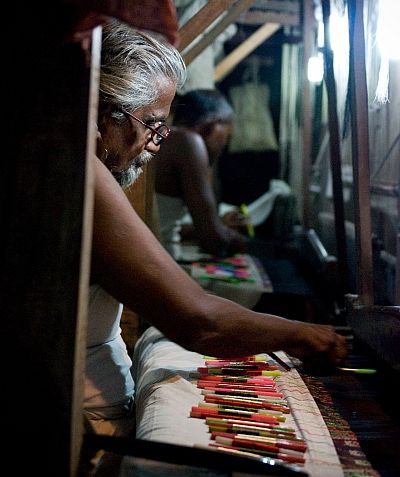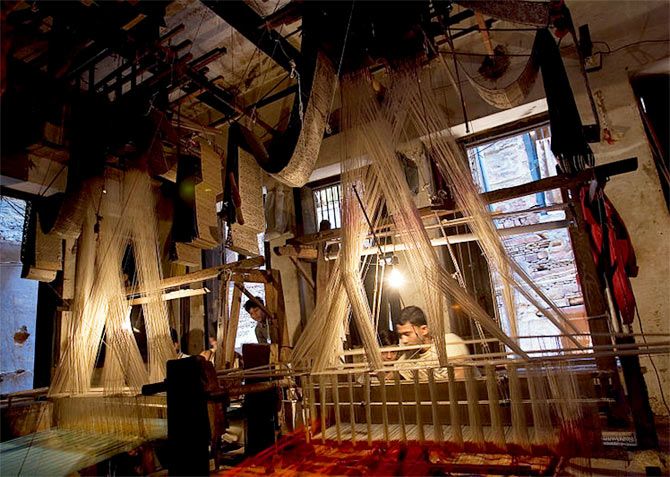 | « Back to article | Print this article |
 Powerlooms and a lack of policy have pushed heritage art towards extinction, say Shreya Jai and Subhayan Chakraborty.
Powerlooms and a lack of policy have pushed heritage art towards extinction, say Shreya Jai and Subhayan Chakraborty.

Five years ago, 50-year-old Prabhu gave up the craft after teaching two generations the art of making Banarasi silk saris.
Powerlooms, low wages and lack of recognition made his mind up for him.
A sudden attack of deafness made him return to the loom with the hope ‘acche din’ would arrive in Prime Minister Narendra Modi’s Lok Sabha constituency.
Earning Rs 250-300 per sari, Prabhu misses the days when he earned Rs 500 a day as a worker on construction sites.
One handwoven Banarasi sari takes five days to weave. A basic silk sari sells for Rs 1,500-2,000 in Varanasi and by the time it reaches customers in Delhi and Mumbai, its price climbs to Rs 4,000-5,000.
“Workers have fled en masse to take up construction work, government jobs. Any job pays more than handloom weaving. This is the irony: look at the painstaking effort that goes into making one saree and the returns from it,” says a trader in Shivala, the centre for handloom weaving in this ancient city.
Mechanisation is a problem but demonetisation has added to weavers’ woes.
“Weavers are usually Muslims. They are completely dependent on cash. Workers are not being paid in the peak wedding season. Some big orders also stand cancelled,” says a sari seller.
Government incentives like access to cheaper loans for machines and subsidised electricity promote powerlooms. The government has initiated a number of projects in the region, after recognising it as a big handloom cluster, an official points out.
The Integrated Handloom Cluster Development Scheme of the Union textile ministry is aimed at market development and creating modern production facilities for weavers. The ministry has roped in celebrities and fashion designers for its ‘I wear handloom’ campaign.
“It hardly helps. We are not recognised anywhere. An art is dying in the country and no one is bothered,” says a trade union leader for Banarasi weavers.
Alok Kumar, development commissioner (handloom), dismisses suggestions that only powerlooms are being promoted. “The government places equal importance on both,” he says. But he adds cheaper goods, produced faster due to mechanisation, have implications for a developing nation like India.
The government is also not sure about the number of weavers because figures date back to 2009-10. “Even counting us as artisans would help. We can’t replace the machine, but the art needs to live,” says the trade union leader.
Kumar says a new survey will be conducted next year.
The Ahmedabad-based Entrepreneurship Development Institute estimates 40,000 households in Varanasi depend on handloom weaving. Their annual turnover is Rs 400 crore.
The textile ministry labels handloom weaving as self-employed business, but a significant number of unskilled workers are left out. The government says a standard wage structure will amount to interference in privately-held businesses.
“Also, there is a need to contextualise the earnings with the amount of work done by the people,” Kumar says.
Many master craftsmen do not save enough to start their own units after decades at the loom.
As Prabhu explains the procedure to a 12-year-old sitting next to him, he adds, “Jeena yahan, marna yahan (you live here and die here too).”